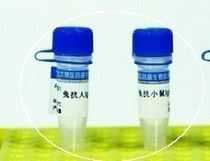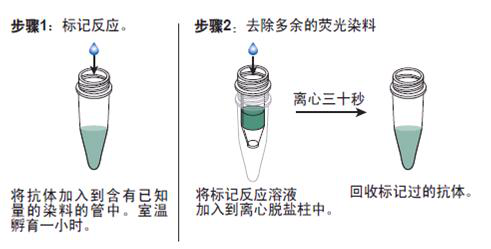
|

| 产地 | 进口、国产 |
| 品牌 | 上海莼试 |
| 保存条件 | Store at -20 °C |
| 货号 | CS9824 |
| 应用范围 | WB=1:100-500 ELISA=1:500-1000 IHC-P=1:100-500 IHC-F=1:100-500 ICC=1:100-500 IF=1:100-500 |
| CAS编号 | |
| 抗体名 | Anti-nitrated Alpha-synuclein (nitro-Tyr39) |
| 克隆性 | |
| 靶点 | 详见说明书 |
| 适应物种 | 详见说明书 |
| 形态 | 详见说明书 |
| 宿主 | 详见说明书 |
| 亚型 | IgG |
| 标识物 | 详见说明书 |
| 浓度 | 1mg/1ml% |
| 免疫原 | KLH conjugated Synthesised nitrylpeptide derived from human Alpha-synuclein around the nitrosation site of Tyr39 |
产品订购信息:
英文名称 Anti-nitrated Alpha-synuclein (nitro-Tyr39)
中文名称 硝基化α-突触核蛋白说明书
别 名 SYUA_HUMAN; nitrated Alpha-synuclein (nitrated-Tyr39); nitrated Alpha-synuclein (nitro-Tyr39); nitrated Alpha synuclein; nitrated Alpha-Synuclein; Alpha synuclein; Alpha-synuclein, isoform NACP140; alphaSYN; MGC105443; MGC110988; MGC127560; MGC64356; NACP; Non A beta component of AD amyloid; Non A4 component of amyloid precursor; Non-A-beta component of alzheimers disease amyloid , precursor of; PARK 1; PARK 4; PARK1; PARK4; Parkinson disease familial 1; PD 1; PD1; SNCA; Snca synuclein, alpha (non A4 component of amyloid precursor); Synuclein alpha; Synuclein, alpha (non A4 component of amyloid precursor).


浓 度 1mg/1ml
规 格 0.1ml/200μg
抗体来源 Rabbit
克隆类型 polyclonal
交叉反应 Human, Mouse, Rat, Chicken, Dog, Pig, Cow, Horse, Rabbit, Sheep, Guinea Pig
产品类型 一抗
研究领域 细胞生物 神经生物学 细胞凋亡
蛋白分子量 predicted molecular weight: 15kDa
性 状 Lyophilized or Liquid
免 疫 原 KLH conjugated Synthesised nitrylpeptide derived from human Alpha-synuclein around the nitrosation site of Tyr39
亚 型 IgG
纯化方法 affinity purified by Protein A
储 存 液 Preservative: 15mM Sodium Azide, Constituents: 1% BSA, 0.01M PBS, pH 7.4
硝基化α-突触核蛋白说明书 产品应用 WB=1:100-500 ELISA=1:500-1000 IHC-P=1:100-500 IHC-F=1:100-500 ICC=1:100-500 IF=1:100-500
(石蜡切片需做抗原修复)
not yet tested in other applications.
optimal dilutions/concentrations should be determined by the end user.
保存条件 Store at -20 °C for one year. Avoid repeated freeze/thaw cycles. The lyophilized antibody is stable at room temperature for at least one month and for greater than a year when kept at -20°C. When reconstituted in sterile pH 7.4 0.01M PBS or diluent of antibody the antibody is stable for at least two weeks at 2-4 °C.
Important Note This product as supplied is intended for research use only, not for use in human, therapeutic or diagnostic applications.
产品介绍 The synuclein family members, including Alpha-synuclein (also designated NACP for non-Beta-Amyloid component) and Beta-synuclein, are predominantly expressed in the brain and are speculated to be involved in synaptic regulation and neuronal plasticity. Alpha-synuclein is localized to neuronal cell bodies and synapses. Alpha-synuclein was first identified as a component of Alzheimer’s disease amyloid plaques. Abnormal platelet function in Alzheimer’s disease has been demonstrated. During megakaryocytic differentiation Alpha-synuclein has been found to be upregulated, while Beta-synuclein is downregulated, indicating that coordinate expression of synucleins may be important during hematopoetic cell differentiation. A mutant form of Alpha-synuclein has been found in patients with early onset Parkinson’s disease.
Function : May be involved in the regulation of dopamine release and transport. Induces fibrillization of microtubule-associated protein tau. Reduces neuronal responsiveness to various apoptotic stimuli, leading to a decreased caspase-3 activation.Subunit : Soluble monomer which can form filamentous aggregates. Interacts with UCHL1. Interacts with phospholipase D and histones.Subcellular Location : Cytoplasm. Membrane. Nucleus. Cell junction, synapse. Note=Membrane-bound in dopaminergic neurons.Tissue Specificity : Expressed principally in brain but is also expressed in low concentrations in all tissues examined except in liver. Concentrated in presynaptic nerve terminals.Post-translational modifications : Phosphorylated, predominantly on serine residues. Phosphorylation by CK1 appears to occur on residues distinct from the residue phosphorylated by other kinases. Phosphorylation of Ser-129 is selective and extensive in synucleinopathy lesions. In vitro, phosphorylation at Ser-129 promoted insoluble fibril formation. Phosphorylated on Tyr-125 by a PTK2B-dependent pathway upon osmotic stress.Hallmark lesions of neurodegenerative synucleinopathies contain alpha-synuclein that is modified by nitration of tyrosine residues and possibly by dityrosine cross-linking to generated stable oligomers.Ubiquitinated. The predominant conjugate is the diubiquitinated form.DISEASE : Note=Genetic alterations of SNCA resulting in aberrant polymerization into fibrils, are associated with several neurodegenerative diseases (synucleinopathies). SNCA fibrillar aggregates represent the major non A-beta component of Alzheimer disease amyloid plaque, and a major component of Lewy body inclusions. They are also found within Lewy body (LB)-like intraneuronal inclusions, glial inclusions and axonal spheroids in neurodegeneration with brain iron accumulation type 1.Defects in SNCA are the cause of Parkinson disease type 1 (PARK1) [MIM:168601]. A complex neurodegenerative disorder characterized by bradykinesia, resting tremor, muscular rigidity and postural instability. Additional features are characteristic postural abnormalities, dysautonomia, dystonic cramps, and dementia. The pathology of Parkinson disease involves the loss of dopaminergic neurons in the substantia nigra and the presence of Lewy bodies (intraneuronal accumulations of aggregated proteins), in surviving neurons in various areas of the brain. The disease is progressive and usually manifests after the age of 50 years, although early-onset cases (before 50 years) are known. The majority of the cases are sporadic suggesting a multifactorial etiology based on environmental and genetic factors. However, some patients present with a positive family history for the disease. Familial forms of the disease usually begin at earlier ages and are associated with atypical clinical features.Defects in SNCA are the cause of Parkinson disease type 4 (PARK4) [MIM:605543]. A complex neurodegenerative disorder with manifestations ranging from typical Parkinson disease to dementia with Lewy bodies. Clinical features include parkinsonian symptoms (tremor, rigidity, postural instability and bradykinesia), dementia, diffuse Lewy body pathology, autonomic dysfunction, hallucinations and paranoia.Defects in SNCA are the cause of dementia Lewy body (DLB) [MIM:127750]. A neurodegenerative disorder clinically characterized by mental impairment leading to dementia, parkinsonism, often with fluctuating cognitive function, visual hallucinations, falls, syncopal episodes, and sensitivity to neuroleptic medication. Brainstem or cortical intraneuronal accumulations of aggregated proteins (Lewy bodies) are the only essential pathologic features. Patients may also have hippocampal and neocortical senile plaques, sometimes in sufficient number to fulfill the diagnostic criteria for Alzheimer disease.Similarity : Belongs to the synuclein family.

Human Resistin ELISA KIT 人抵抗素Multi-class antibodies规格: 48T
Anti-MMP-12 基质金属蛋白酶-12抗体Multi-class antibodies规格: 0.1ml
Rhesus antibody Rh Integrin Alpha X/CD11c 整合素αX抗体 规格 0.1ml
IL-11 ELISA Kit 大鼠白介素11 96T
Proteasome 20S C2 英文名称: 蛋白酶体PSMα1抗体 0.2ml
C7orf53 英文名称: 7号染色体开放阅读框53抗体 0.2ml
Anti-MMP-12 基质金属蛋白酶-12抗体Multi-class antibodies规格: 0.1ml
MECF(ouse eosinophil chemotactic factor) ELISA Kit 小鼠嗜酸粒细胞趋化因子Multi-class antibodies规格: 48T
Anti-ISR- Alpha/RBITC 红色荧光素罗丹明标记(RBITC)受体-α抗体IgG(标记抗体)Multi-class antibodies规格: 0.2ml
Rhesus antibody Rh ENaCg/γENaC 上皮离子通道蛋白γ抗体 规格 0.2ml
Mouse reduced glutathione,GSH ELISA Kit 小鼠还原型谷胱甘肽 96T
MIG5 英文名称: 细胞迁移诱导因子5抗体 0.1ml
ATG4A 英文名称: 自噬相关蛋白4A抗体 0.2ml
Anti-ISR- Alpha/RBITC 红色荧光素罗丹明标记(RBITC)受体-α抗体IgG(标记抗体)Multi-class antibodies规格: 0.2ml
ANG-2(Human Angiopoietin 2) ELISA Kit 人生成素2Multi-class antibodies规格: 48T
Anti-PAK4 p21激活激酶4抗体Multi-class antibodies规格: 0.2ml
Rhesus antibody Rh HPV16 E6 + HPV18 E6 人类状瘤病毒16/18 E6抗体 规格 0.2ml
Amylin(Mouse Amylin) ELISA Kit 小鼠胰淀素 96T
Phospho-PDGF Receptor beta (Tyr1009) 英文名称: 磷酸化血小板源性生长因子受体-B抗体 0.1ml
CACNA1G + CACNA1H 英文名称: 电压依赖性钙通道CACNA1G+CACNA1H抗体 0.2ml
Anti-PAK4 p21激活激酶4抗体Multi-class antibodies规格: 0.2ml
SoybeanCaseinDigestAgarMedium
ECC显色培养基A 1000 mL/瓶 incubation media ECC显色培养基A 1000 mL/瓶
血琼脂培养基基础 250g 加入脱纤维羊血或兔血,制成血琼脂培养基,用于营养要求较高的细菌的培养及溶血试验(GB 4789.10-...
琼脂培养基KAgarmediumK(Xylose,lysine,deoxycholateagar)用于沙门氏菌选择性分离培养
M17肉汤 250g 用于牛奶和乳制品中乳酸菌检测和分离培养
MycoplasmaBrothMedium
氯-蛋白胨缓冲液(pH7.0) 250(g) incubation media 氯-蛋白胨缓冲液(pH7.0) 250(g)
月桂基盐胰蛋白胨肉汤(LST) 250g 用于多管发酵法测定大肠菌群和粪大肠菌GB 4789.3-2010,GB/T 4789.38-2008,GB/T 4789.39-200...
抗生素检定培养基6号AntibioticAgarNO.6用于粘菌素等的效价测定
缓冲甘油-氯溶液 250g 用于检测产气荚膜梭菌时样品的贮存
硝基化α-突触核蛋白说明书 卵磷脂-吐温80营养琼脂 规格: 250g 用途: 用于化妆品细菌总数测定。(化妆品卫生规范微生物检验方法2007版,SN/T 2098-2008)。
改良卵磷脂肉汤 规格: 250g 用途: 用于化妆品微生物检测中样品稀释和增菌。(FDA BAM Chapter 23,ISO 21149:2006,ISO 22718:200...
脑心浸出液肉汤BHI 规格: 100g 用途: 广泛用于霉菌、酵母、细菌的培养,包括营养要求较高的微生物的培养,特别用于食品卫生微生物检验...
麦芽浸膏汤 规格: 250g 用途: 用于酵母和霉菌的培养,还用于酸性罐头食品商业无菌检验(GB/T4789.26-2003)。

抗体的生物素化标记实验要点:
1. 硝基化α-突触核蛋白说明书 如在反应混合液中有叠氮钠或游离氨基存在,会抑制标记反应。因此,蛋白质在反应前要对 0.1mol/L碳酸氢钠缓冲液或0.5mol/L硼酸缓冲液充分透析;
2.所用的NHSB及待生物素化蛋白质之间的分子比按蛋白质表面的ε-氨基的密度会有所不同,选择不当则影响标记的效率,应先用几个不同的分子比来筛选最适条件;
3.用NHSB量过量也是不利的,抗原的结合位点可能因此被封闭,导致抗体失活;
4.由于抗体的氨基不易接近可能造成生物素化不足,此时可加入去污剂如 Triton x-100, Tween20等;
5.当游离ε-氨基(赖氨酸残基的氨基)存在于抗体的抗原结合位点时,或位于酶的催化位点时,生物素化会降低或损伤抗体蛋白的结合力或活性;
6.生物素还可能与不同的功能基团,如羰基、氨基、巯基、异咪唑基及*基,也可与糖基共价结合;
7.交联反应后,应充分透析,否则,残余的生物素会对生物素化抗体与亲和素的结合产生竞争作用;
8.在细胞的荧光标记实验中,中和亲和素的本底低,但由于链霉亲和素含有少量正电荷,故对某些细胞可导致高本底。
抗体的鉴定:
1)硝基化α-突触核蛋白说明书 抗体的效价鉴定:不管是用于诊断还是用于,制备抗体的目的都是要求较高效价。不同的抗原制备的抗体,要求的效价不一。鉴定效价的方法很多,包括有试管凝集反应,琼脂扩散试验,酶联免疫吸附试验等。常用的抗原所制备的抗体一般都有约成的鉴定效价的方法,以资比较。如制备抗抗体的效价,一般就采用琼脂扩散试验来鉴定。
2)抗体的特异性鉴定:抗体的特异性是指与相应抗原或近似抗原物质的识别能力。抗体的特异性高,它的识别能力就强。衡量特异性通常以交叉反应率来表示。交叉反应率可用竞争抑制试验测定。以不同浓度抗原和近似抗原分别做竞争抑制曲线,计算各自的结合率,求出各自在IC50时的浓度,并按公式计算交叉反应率。
如果所用抗原浓度IC50浓度为pg/管,而一些近似抗原物质的IC50浓度几乎是无穷大时,表示这一抗血清与其他抗原物质的交叉反应率近似为0,即该血清的特异性较好。
3)抗体亲和力:是指抗体和抗原结合的牢固程度。亲和力的高低是由抗原分子的大小,抗体分子的结合位点与抗原决定簇之间立体构型的合适度决定的。有助于维持抗原抗体复合物稳定的分子间力有氢键,疏水键,侧链相反电荷基因的库仑力,范德华力和空间斥力。亲和力常以亲和常数K表示,K的单位是L/mol。抗体亲和力的测定对抗体的筛选,确定抗体的用途,验证抗体的均一性等均有重要意义。